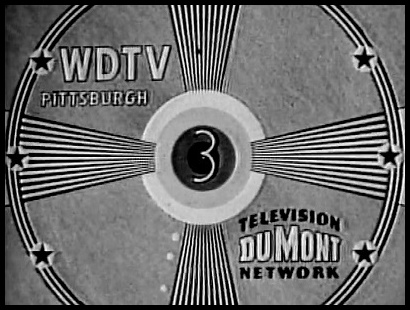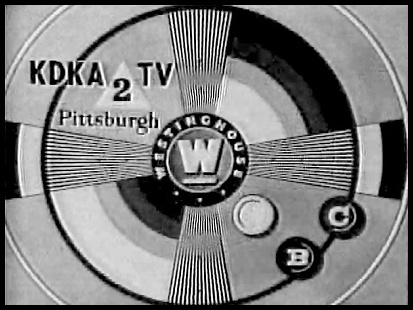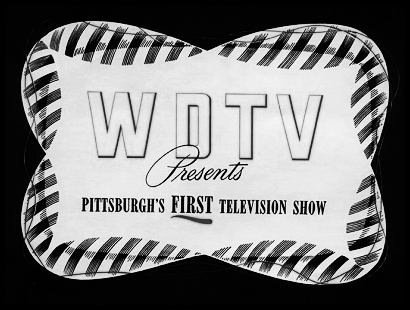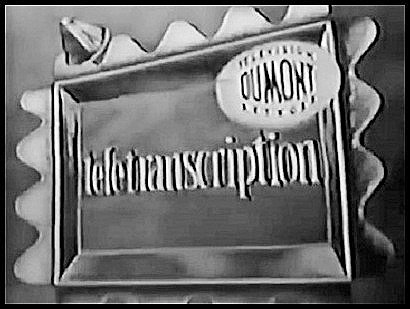Channel  : Pittsburgh : Pittsburgh

"Pittsburgh was terrific. It had a gross income
of six million dollars and a net of four million
dollars. It supported the network."
Ted Bergmann, former managing director of the
DuMont network, in Jeff Kisseloff's
The Box (see Channel 11).
DuMont would probably not have survived at all if it
weren't for their stranglehold on a very large market. In Pittsburgh,
which was a Top Ten market in those days, DuMont owned and operated WDTV
(channel 3) from 1949 until 1955. There were no other commercial VHF
stations in the city until the late 1950's, and although UHF stations
signed on the air, few people could receive them, and fewer actually
watched them. So WDTV had a de facto monopoly -- viewers watched DuMont
in Pittsburgh, or they didn't watch much television. In a 1954 trade
advertisement, DuMont claimed that 94% of the TV sets in the market were
tuned to WDTV. Nowhere else did such a situation exist in such a big
city.
This provided DuMont with a major profit center which
supported the losses of the network. It also gave DuMont leverage with
respect to obtaining air time on the affiliates of the other networks in
large markets, since DuMont had the only VHF station in Pittsburgh on
which the other networks could clear their programming. (It is
instructive that the DuMont network went out of business only a few
months after selling WDTV to Westinghouse in late 1954, by which time it
had switched to Channel 2. Westinghouse re-named the station KDKA-TV,
after its pioneering AM radio outlet.)

WDTV's first day of regular programming came in January
1949. Until then, "live" network programming had been limited to
regional East and Midwest networks. The coaxial cable which fed programs
from one region to another had not yet been completed, and Midwest
stations that wanted to carry programs from New York City could not air
them "live", but were required to use kinescope recordings (see note
below). With the sign-on of WDTV, the East and Midwest were finally
connected. Thus, it was DuMont's WDTV which served as the "Golden Spike"
of network television.

This event was celebrated in a special broadcast which
originated from the Syria Mosque in Pittsburgh and aired on all four
networks on January 11, 1949, and WDTV preceded this "Golden Spike"
broadcast with a local telecast of its own. In his book Broadcasting the Local News (see Channel 11), former Pittsburgh broadcaster Lynn Boyd Hinds describes these programs in considerable detail:
...at 8:30 on Tuesday evening, the test pattern was
replaced with a slide that read: "DuMont Presents -
Your Magic Window." The inaugural program was
broadcast from 8:30 P.M. until 9:30 P.M. ... Because
WDTV had no studio facilities, DuMont brought its
remote truck and the equipment needed for a local
production from New York to Pittsburgh.
Dr. Allen B. DuMont was on hand for a speech and
to present a cathode-ray tube to Pa Pitt (played by
veteran KDKA radio announcer Ed Shaughnessy). The
remainder of the program consisted of an on-stage
variety program featuring local acts...
The locally-produced hour was followed by the
"Golden Spike" ceremony from 9:30 P.M. until 10:00
P.M., a program shared by the four networks, then an
hour-long program in which each network served up a
sampling of its fare. CBS led off with Arthur Godfrey,
puppeteers, then "Douglas Edwards and the News,"
for its fifteen-minute segment; DuMont's quarter-hour
featured Ted Steele and his orchestra; Milton Berle
followed for NBC; and ABC presented a mystery drama,
"Stand By for Crime," originating from Chicago. At
11:00 P.M. on the first evening of television in
Pittsburgh, WDTV signed off.
The next day, newspaper ads in cities like New York City
touted the delivery of "live" programs from Chicago (such as NBC's
"Kukla, Fran and Ollie") for the first time. Although "live"
interconnection to the West Coast would not be completed until 1951, the
modern era of network television had begun.
Across the country, most cities only had two or three TV
stations. With the opening of the coaxial cable, most of these stations
quickly affiliated with CBS and NBC due to the relationship which had
existed since radio days. ABC and DuMont were relegated to sharing a
third TV station, or, in some markets, clearing an hour or two per week
on the CBS or NBC affiliate in town. Even these few hours of programming
were not always live, but often aired via kinescope recordings.

(Note: A kinescope recording, usually shortened by the
industry to a kinescope or kinnie or kine, is a recording of a
television program made by filming it from a monitor using specially
designed film equipment. The word kinescope refers to the picture tube
from which the recording was made. Invented in 1947 by a consortium of
DuMont, NBC, and Kodak, this process was the only real means of
preserving television programs in TV's early years, since videotape
would not arrive until 1956. The picture quality of kinescope recordings
left much to be desired, providing a flat, low-contrast look when
compared to filmed programs, but "kinnies" were widely aired by stations
in the early days of television, and were used by the networks to delay
their "live" East Coast programs for the West Coast. DuMont called
their kinescope recordings teletranscriptions, which may have sounded a
bit more elegant, but presumably did nothing to improve the picture
quality. Ironically, kinescope recordings are now considered rare and in
demand, and a few persist on contemporary television: The Honeymooners "Lost Episodes" are kinescopes, and the Sci-Fi Channel has aired old kinescopes of Tales of Tomorrow and Lights Out! on its Retro TV series.)
Go to Channel 5: Programming
|

